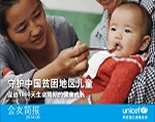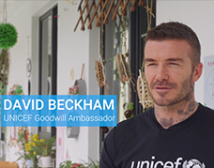NEW YORK/GENEVA, 1 July 2015– Lack of progress on sanitation threatens to undermine the child survival and health benefits from gains in access to safe drinking water, warn WHO and UNICEF in a report tracking access to drinking water and sanitation against the Millennium Development Goals.
 ©UNICEF/UGDA201500345/Nakibuuka ©UNICEF/UGDA201500345/Nakibuuka
A young girl pumps water from borehole in Kapedo Sub County, Kaabong District, North Eastern Uganda. |
The Joint Monitoring Programme report, Progress on Sanitation and Drinking Water: 2015 Update and MDG Assessment, says worldwide, 1 in 3 people, or 2.4 billion, are still without sanitation facilities – including 946 million people who defecate in the open.
"What the data really show is the need to focus on inequalities as the only way to achieve sustainable progress," said Sanjay Wijesekera, head of UNICEF's global water, sanitation and hygiene programmes. "The global model so far has been that the wealthiest move ahead first, and only when they have access do the poorest start catching up. If we are to reach universal access to sanitation by 2030, we need to ensure the poorest start making progress right away."
Access to improved drinking water sources has been a major achievement for countries and the international community. With some 2.6 billion people having gained access since 1990, 91 per cent of the global population now have improved drinking water – and the number is still growing. In sub-Saharan Africa, for example, 427 million people have gained access – an average of 47,000 people per day every day for 25 years.
 ©UNICEF/China/2009/Yang Zhenbo ©UNICEF/China/2009/Yang Zhenbo
Primary school students in Beichuan County, Sichuan Province, learn how to wash their hands correctly. |
The child survival gains have been substantial. Today, fewer than 1,000 children under five die each day from diarrhoea caused by inadequate water, sanitation and hygiene, compared to over 2,000 15 years ago.
On the other hand, the progress on sanitation has been hampered by inadequate investments in behaviour change campaigns, lack of affordable products for the poor, and social norms which accept or even encourage open defecation. Although some 2.1 billion people have gained access to improved sanitation since 1990, the world has missed the MDG target by nearly 700 million people. Today, only 68 per cent of the world's population uses an improved sanitation facility – 9 percentage points below the MDG target of 77 per cent.
"Until everyone has access to adequate sanitation facilities, the quality of water supplies will be undermined and too many people will continue to die from waterborne and water-related diseases," said Dr Maria Neira, Director of the WHO Department of Public Health, Environmental and Social Determinants of Health.
 ©UNICEF/China/2013/Jerry Liu ©UNICEF/China/2013/Jerry Liu
A toilet in a rural school in Hunan Province. |
Access to adequate water, sanitation and hygiene is critical in the prevention and care of 16 of the 17 'neglected tropical diseases' (NTDs), including trachoma, soil-transmitted helminths (intestinal worms) and schistosomiasis. NTDs affect more than 1.5 billion people in 149 countries, causing blindness, disfigurement, permanent disability and death.
The practice of open defecation is also linked to a higher risk of stunting – or chronic malnutrition – which affects 161 million children worldwide, leaving them with irreversible physical and cognitive damage.
"To benefit human health it is vital to further accelerate progress on sanitation, particularly in rural and underserved areas," added Dr Neira.
Rural areas are home to 7 out of 10 people without access to improved sanitation and 9 out of 10 people who defecate in the open.
Plans for the new Sustainable Development Goals to be set by the United Nations General Assembly in September 2015 include a target to eliminate open defecation by 2030. This would require a doubling of current rates of reduction, especially in South Asia and sub-Saharan Africa, WHO and UNICEF say.
WHO and UNICEF say it is vitally important to learn from the uneven progress of the 1990-2015 period to ensure that the SDGs close the inequality gaps and achieve universal access to water and sanitation. To do so, the world needs:
-
Disaggregated data to be able to pinpoint the populations and areas which are outliers from the national averages;
-
A robust and intentional focus on the hardest to reach, particularly the poor in rural areas;
-
Innovative technologies and approaches to bring sustainable sanitation solutions to poor communities at affordable prices;
-
Increased attention to improving hygiene in homes, schools and health care facilities.
###
Related links:
The full report and press materials available atthe following links:
UNICEF: http://uni.cf/1TP1tVM
WHO: http://www.who.int/water_sanitation_health/monitoring/en/
JMP: http://www.wssinfo.org/
Note to Editors:
An "improved" drinking water source is defined as a facility or delivery point that protects water from external contamination – particularly faecal contamination. This includes piped water into a dwelling, plot, or yard; public tap or standpipe; tube-well or borehole; protected spring; and rainwater collection.
-
An "improved" sanitation facility is one that hygienically separates human excreta from human contact.
-
The MDG target for drinking water aimed to have 88% of the population with access to improved sources by 2015.
-
The MDG target for sanitation called for halving the proportion of the population without basic sanitation, thus extending access from 54% to 77% by 2015.
About the JMP
The WHO/UNICEF Joint Monitoring Programme (JMP) for Water Supply and Sanitation is the official United Nations mechanism tasked with monitoring country, regional and global progress, and especially towards the Millennium Development Goal's (MDG) target relating to access to drinking water and sanitation. Thanks to the globally supported household surveys, JMP analysis helps draw connections between access to improved water and sanitation facilities and quality of life, and serves as an authoritative reference to make policy decisions and resource allocations, especially at the international level.
About UNICEF
UNICEF promotes the rights and wellbeing of every child, in everything we do. Together with our partners, we work in 190 countries and territories to translate that commitment into practical action, focusing special effort on reaching the most vulnerable and excluded children, to the benefit of all children, everywhere. For more information about UNICEF and its work visit: www.unicef.org
About WHO
WHO is the directing and coordinating authority for health within the United Nations system. It is responsible for providing leadership on global health matters, shaping the health research agenda, setting norms and standards, articulating evidence-based policy options, providing technical support to countries, and monitoring and assessing health trends and improving global health security. For more information about WHO and its work, visit www.who.int
For more information please contact:
In New York
Rita Ann Wallace, UNICEF New York, Tel: +1 212 326 7586, Mobile: +1 917 213 4043, rwallace@unicef.org
Angelica Spraggins, WHO New York, Tel: + 1 917 388 5562, spragginsan@who.int
In Geneva
Fadéla Chaib, WHO Geneva, Tel: +41 22 791 3228, Mobile: +41 79 475 5556, chaibf@who.int
Nada Osseiran, WHO Geneva, Tel: +41 22 791 4475, Mobile: +41 79 445 1624, osseirann@who.int
Christophe Boulierac, UNICEF Geneva, Mobile: +41 (0) 799639244, Tel: +41 (0)22 909 5716, cboulierac@unicef.org
Visit UNICEF China website: www.unicef.cn
Follow us: Sina Weibohttp://weibo.com/unicefchina Tecent Weibo http://t.qq.com/unicef
Wechat: unicefchina

For further information, please contact:
Shantha Bloemen, UNICEF China, +8610 85312610, sbloemen@unicef.orgor Liu Li, UNICEF China, +8610 85312612, liliu@unicef.org
































